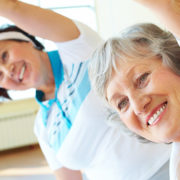Chronic Pain? This Mindfulness Technique Might Change That
Article by Kristen Peck | Found on MindBodyGreen
I’m quick to regret the label of chronic pain. I believe in the power of words and thoughts, so the idea of labeling a consistent pain as “chronic” feels like a resignation of control and possibility. For about two and a half years now, I’ve experienced persistent little nudges and discomfort in various parts of my bodies—mostly symptoms of carpal tunnel syndrome, joint pain, and the general discomfort that comes along with a desk job. Yes, I visited doctors and specialists to no avail and eventually turned to alternative healing modalities—like acupuncture, exercise, hot and cold therapy, physical therapy—searching for answers in the form of relief, management, and prevention. And while these methods worked, only temporarily so. Plus, I never feel that these practices address the root of the pain circulating throughout my body, which is sharp and rarely dormant these days.
Recently, my symptoms have fluctuated in and out of remission, except for, I noticed, during the periods of heightened stress and anxiousness, which seemed to exacerbate the symptoms. On my quest to further investigate the mind-body connection in relation to pain and body trauma, I stumbled across Pyeng Threadgill’s work with mindful movement.
“It’s about guiding people on how to be more integrated into all areas of your life. It’s a practice, not an overnight thing.”
Threadgill came across the Alexander Technique years ago as a vocalist and performer looking for tools to help strengthen her voice and body instruments. “I learned a lot about how we’re using our whole system. There’s an opportunity for openness. Time feels less rushed,” she told mbg during a session at her studio in Brooklyn. Today, she’s a certified instructor who’s reframed the technique as mindfulness and movement re-education to help everyday people focus on their movement habits and the stresses that can trigger chronic injuries and pain. “It’s about guiding people on how to be more integrated into all areas of your life. It’s a practice, not an overnight thing.”
During our session, Threadgill led me through a series of exercises steeped in awareness and conversation. Different from other bodywork treatments like massage, both Pyeng and I guided the treatment, with Pyeng adjusting the moves depending on how I responded to a particular feeling, a gentle pull on my arm there, a guided neck stretch here. After all, one of the primary principles of the technique is cultivating awareness. She explained that the moves were to help retrain the nervous system. “A lot of what we’re connecting to is connective tissue—loosening the grip of connective tissue to allow the muscles underneath to move more freely.”
I walked away from my session with Pyeng lighter and with remarkably less tension and tightness. If we all learned to think about our full alignment and our daily habits, could we shift the conversation on chronic pain from coping to healing? Pyeng’s take: “It’s about the liberation from identifying with your energies. If we can recognize our body and habits, we can change the course of our movement and, ultimately, our outlook on pain.”
Below, Pyeng offers up four tips for incorporating mindful movement into your own life.
1. Bring your smartphone to eye level.
Pyeng notes smartphone usage as a major factor in body alignment issues. “Since so many people are using smartphones nowadays, it is important to raise your smartphone more often when texting, typing, or reading. This takes practice, but it will reveal how often you are closing off the front of the throat and therefore, part of your body’s lengthening and widening potential.” She says a question to ask is, “How can I allow my body to lengthen with ease?”
2. Notice your breath.
A key element of Mindful Movement is to practice noticing your body and habits while engaging with the world. Part of this engagement, Pyeng says, starts with our breath and “how it feels to pay attention to your breath with your eyes opened.” In what ways can you use less force or holding when breathing while fully present in a task, chore, or activity.
3. Walk with intention.
Try to look out at eye height when walking. Oftentimes, so many people look down when they walk, and as a result, they reinforce the shortening of their spines and entire torso by forgetting that we, like any other animal, lead our movement with our eyes and head, followed by our bodies.
4. Slow down and sense your breath and body.
Most of us get so wrapped up in any given task that we forget to sense ourselves. It’s as if we are TOO focused on the bull’s-eye to remember our feet being on the ground and heads being light above. Set a timer once an hour for a five-minute pause to take inventory of your body. Instead ask yourself what you notice in your body while sitting in a chair, your car, or even standing in line.
Grounded in the belief we are all unique beings, we begin each new client with a meticulous bio-mechanical evaluation, assessing each joint in its relationship to the movement of the body as a whole. Our therapists are skilled at reading the unique story your body tells, and treating everything from the bottom of your foot to the top of your head.
Bodywise Physical Therapy is located in Portland, Oregon. The Bodywise approach is wholistic, individualized, and can benefit people of all fitness levels. While Bodywise has always specialized in general orthopedics, spine rehabilitation, and sports medicine, they have evolved into a truly wholistic practice integrating Hands-on treatments with Mindfulness, Pilates, Trauma Release Exercise, Womens Health and Lymphedema.

